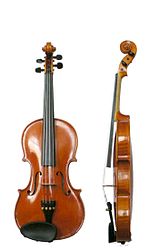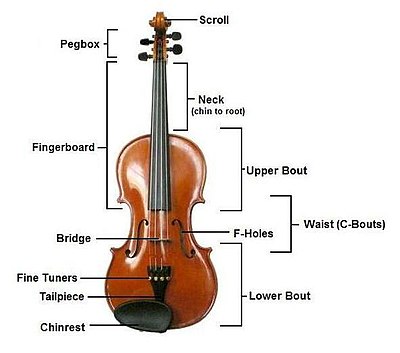វីយោឡុង
 ខ្នាតគំរូជារបៀបទាន់សម័យ មើលពីមុខ និង ពីចំហៀង | |
| តន្ត្រីប្រភេទខ្សែ | |
|---|---|
| Other names | ហ្វីដដល (Fiddle) , de: Violine or Geige, fr: Violon, it: Violino |
| Hornbostel-Sachs classification | 321.322-71 (ផ្សំឡើងដោយ សំឡេងខ្សែ ប្រដេញដោយកំនោង) |
| Developed | មុនសតវត្សទី១៦ |
| Playing range | |
 | |
| Related instruments | |
| |
| Musicians | |
- Numbered list item
វីយោឡុង គឺជាប្រភេទឧបករណ៍តន្ត្រីខ្សែ ដែលមានខែ្សបួន។ បើធៀបទៅហ្នឹង ឧបករណ៍តន្ត្រីបូរាណខ្មែរវិញ វាមានលក្ខណៈស្រដៀងនឹងទ្រ។ វីយោឡុងមានទំហំតូចជាងគេ តែមានសំឡេងខ្ពស់ជាងគេក្នុងចំណោម[[ឧបករណ៍តន្ត្រី]ប្រភេទក្រុមគ្រួសារនៃវិយោឡុងជារបៀបខ្សែទាំងអស់ ដោយក្នុងនោះរាប់បញ្ចូលទាំងវីយោឡានិងសេឡូផងដែរ។
វីយោឡុង ពេលខ្លះ គេអាចហៅម្យ៉ាងទៀតថា Fiddle(ហ្វីដដល) ពោលគឺ អាស្រ័យទៅលើការចំណាំហៅក្នុងការប្រើប្រាស់វា។ ពាក្យថាវីយោឡុង មានកំណើតមកពីពាក្យរបស់ភាសាឡាទីន Vitula(វីទូឡា) ដែលមានន័យថាឧបករណ៍តន្ត្រីប្រើខ្សែ។ ទោះជាវីយូឡុង មានឬសគល់តាំងពីបុរាណមកក៏ដោយ លក្ខណៈបច្ចុប្បន្នរបស់វា គឺទទួលបានពីគម្រូនៃប្រទេសអ៊ីតាលី នាសតវត្សទី១៦ ដែលឆ្លងកាត់ការវិវឌ្ឍន៍ផ្សេងៗទៀត នាសតវត្សទី១៨។ [1] ពាក្យនេះ គេជឿថា បន្ទាប់មកបានក្លាយទៅជាពាក្យ «Fiddle (ហ្វីដដល)» នេះតែម្ដង។ ក្រុមតន្ត្រីករវីយោឡុង និងក្រុមអ្នកប្រមូលនូវភាពដោយឡែកនៃតម្លែរបស់ឧបករណ៍ ត្រូវបានបង្កើតឡើងដោយ Gasparo da Salò (ហ្កាស្ប៉ារ៉ូ ដា សាឡូ),Paolo Maggini (ផៅឡូ ម៉ាហ្គីនី), Stradivari (ស្ត្រាឌីវ៉ារី), Guarneri (ហ្កឺនឺរី) និង Amati families (គ្រួសាររបស់អាម៉ាទី) ចាប់តាំងពីសតវត្សន៍ទី១៦ ដល់សតវត្សន៍ទី១៩ នៅ Brescia(ប្រីចស្គីយ៉ា) Cremona(គ្រេមូណា) និងដោយ Jacob Stainer(ចាខូប ស្តេននឺ) នៅឯ អូស្ត្រាលី។
ប្រវត្តិ
[កែប្រែ]
ប្រភេទខ្សែរបស់វីយោឡុងនេះ ក៏អាចប្រើសម្រាប់កេះផងដែរ (ឧ. the Greek lyre). ឧបករណ៍តន្ត្រី Bowed ប្រហែលជា ផ្ដើមមានវត្តមានដំបូងគេនៅក្នុង equestrian វប្បធម៌នៃអាស៊ីកណ្ដាល, ជាភស្ដុតាង Kobyz (កាហ្សាក់: қобыз) or kyl-kobyz ដែលជាវត្ថុបូរាណ Turkic, Kazakh string instrument ឬ Mongolian ជាឧបករណ៍ Morin huur:
- អ្នកជិះសេះនៃប្រជាជនTurkic and Mongolian ដែលមកពីខាងក្នុងនៃ ទ្វីបអាស៊ី ទំនងជាអ្នកកាន់ឧបករណ៍ហ្វីដដល មុនគេក្នុងពិភពលោក។ មានទាំងអស់ខ្សែពីរ គឺឆ្វេងនិងស្ដាំ ខ្សែរបស់ហ្វីដដលត្រូវបានបង្កើតឡើងអំពីខ្សែរោមសេះ ដែលកូដជាមួយនឹងដងផលិតពីរោមសេះដូចគ្នាដែរ និងជារឿយៗរោមដែលគេប្រើប្រាស់គឺជារោមដែលឋិតនៅតំបន់ពីក្បាលសេះដល់ត្រឹមក។
ជារួម វីយោឡុង, វីយោឡា, និង សេឡូ គឺសម្រាប់កូតលេងរាល់ថ្ងៃ និងដែលដងរបស់វាគឺនៅតែបន្តផលិតអំពីសរសៃរោមរបស់សេះ រហូតទាល់តែជាកេរ្តិ៍មរតកនៃចរកជន ឬអ្នករសាត់អណ្ដែត។[១]
It is believed that these instruments eventually spread to China, India, the Byzantine Empire and the Middle East, where they developed into instruments such as the erhu in China, the rebab in the Middle East, the lyra in the Byzantine Empire and the esraj in India. The violin in its present form emerged in early 16th-Century Northern Italy, where the port towns of Venice and Genoa maintained extensive ties to central Asia through the trade routes of the silk road.
The modern European violin evolved from various bowed stringed instruments from the Middle East[២] and the Byzantine Empire.[៣][៤] It is most likely that the first makers of violins borrowed from three types of current instruments: the rebec, in use since the 10th century (itself derived from the Byzantine lyra[៥] and the Arabic rebab), the Renaissance fiddle, and the lira da braccio[៦] (derived[៣] from the Byzantine lira). One of the earliest explicit descriptions of the instrument, including its tuning, was in the Epitome musical by Jambe de Fer, published in Lyon in 1556.[៧] By this time, the violin had already begun to spread throughout Europe.
The oldest documented violin to have four strings, like the modern violin, is supposed to have been constructed in 1555 by Andrea Amati, but the date is very doubtful. (Other violins, documented significantly earlier, only had three strings and were called violetta.) The violin immediately became very popular, both among street musicians and the nobility, illustrated by the fact that the French king Charles IX ordered Amati to construct 24 violins for him in 1560.[៨] The oldest surviving violin, dated inside, is from this set, and is known as the Charles IX, made in Cremona c. 1560. The finest Renaissance carved and decorated violin in the world is the Gasparo da Salò (1574 c.) owned by Ferdinand II, Archduke of Austria and later, from 1841, by the Norwegian virtuoso Ole Bull, who used it for forty years and thousands of concerts, for his very powerful and beautiful tone, similar to those of a Guarneri. It is now in the Vestlandske Kustindustrimuseum in Bergen (Norway). "The Messiah" or "Le Messie" (also known as the "Salabue") made by Antonio Stradivari in 1716 remains pristine. It is now located in the Ashmolean Museum of Oxford.[៩]

The most famous violin makers (luthiers) between the 16th century and the 18th century include:
- The school of Brescia, beginning in the late 14th with liras, violettas, violas and active in the field of the violin in the first half of 16th century
- The Dalla Corna family, active 1510–1560 in Brescia and Venezia, Italy
- The Micheli family, active 1530–1615 in Brescia
- The Inverardi family active 1550–1580 in Brescia
- The Bertolotti Gasparo da Salò family, active 1530–1615 in Salò and Brescia
- Giovanni Paolo Maggini, active 1600–1630 in Brescia
- The school of Cremona, beginning in the half of 16 century vith violas and violone and in the field of violin in the second half of 16 century
- The Amati family, active 1500–1740 in Cremona, Italy
- The Guarneri family, active 1626–1744 in Cremona
- The Stradivari family, active 1644–1737 in Cremona
Significant changes occurred in the construction of the violin in the 18th century, particularly in the length and angle of the neck, as well as a heavier bass bar. The majority of old instruments have undergone these modifications, and hence are in a significantly different state than when they left the hands of their makers, doubtless with differences in sound and response.[១០] But these instruments in their present condition set the standard for perfection in violin craftsmanship and sound, and violin makers all over the world try to come as close to this ideal as possible.
To this day, instruments from the so-called Golden Age of violin making, especially those made by Stradivari and Guarneri del Gesù, are the most sought-after instruments by both collectors and performers. The current record amount paid for a Stradivari violin is £9.8 million (US$15.9 million), when the instrument known as the Lady Blunt was sold by Tarisio Auctions in an online auction on June 20, 2011.[១១]
ការផលិត
[កែប្រែ]
ការលេងវិយោឡុង
[កែប្រែ]តន្ត្រី
[កែប្រែ]តន្ត្រីករវិយោឡុងល្បីៗ
[កែប្រែ]ឯកសារយោង
[កែប្រែ]- ↑ "The Silk Road: Connecting Cultures, Creating Trust, Silk Road Story 2: Bowed Instruments". Smithsonian Center for Folk life and Cultural Heritage. Archived from the original on 2008-10-13. Retrieved 2008-09-26.
- ↑ Hoffman, Miles. "The NPR Classical Music Companion: Terms and Concepts from A to Z". Chicago Symphony Orchestra. Archived from the original on 2008-12-07. Retrieved 2008-09-26.
- ↑ ៣,០ ៣,១ Grillet 1901, ទ. 29
- ↑ Margaret J. Kartomi: On Concepts and Classifications of Musical Instruments. Chicago Studies in Ethnomusicology, University of Chicago Press, 1990
- ↑ Panum, Hortense (1939). "The stringed instruments of the Middle Ages, their evolution and development".
- ↑ Arkenberg, Rebecca (2002). "Renaissance Violins". Metropolitan Museum of Art. Retrieved 2006-09-22.
{{cite web}}: Unknown parameter|month=ignored (help) - ↑ Deverich, Robin Kay (2006). "Historical Background of the Violin". ViolinOnline.com. Retrieved 2006-09-22.
- ↑ Bartruff, William. "The History of the Violin". Archived from the original on 2007-02-08. Retrieved 2006-09-22.
- ↑ "Violin by Antonio Stradivari, 1716 (Messiah; la Messie, Salabue)". Cozio.com. Archived from the original on 2008-10-08. Retrieved 2008-09-26.
- ↑ Richard Perras. "Violin changes by 1800". Retrieved 2006-10-29.
- ↑ "Stradivarius violin sold for £9.8m at charity auction". BBC News. 2011-06-21. http://www.bbc.co.uk/news/entertainment-arts-13852872។ បានយកមក 2011-06-21.
